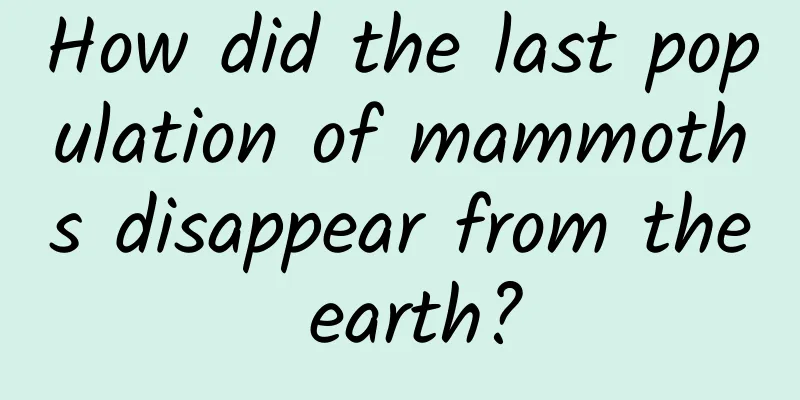How did the last population of mammoths disappear from the earth?

|
As a species that "just" became extinct 4,000 years ago, how did the mammoth disappear from the earth? This question has always attracted scientists to explore. The Wrangel Island, isolated from the mainland, once lived the last population of mammoths, making it an ideal place for researchers to find the answer. A new study published in the journal Cell overturns the long-held belief that isolated mammoth populations on Wrangel Island eventually went extinct due to inbreeding and genetic defects. In other words, genetic problems caused by inbreeding may not have been the cause of their extinction, and their story is more complicated than previously understood. Written by | Mumu In the movie "Ice Age", the three animal protagonists, Manny the mammoth, Sid the sloth, and Diego the saber-toothed tiger, who were originally natural enemies, help each other and grow together in order to survive in the harsh natural environment. Among them, the huge Manny is taciturn and gentle, and deep in his heart he hides the sadness of losing his family. Behind this story full of warmth and humor, it also implies the profound impact of the great changes in the natural environment on the fate of some species in that distant ice age. The movie "Ice Age" In fact, woolly mammoths (Mammuthus primigenius) were one of the most widespread large herbivores on Earth during the last Ice Age. But by the end of the Late Pleistocene (about 10,000 years ago), they had disappeared from most of the Earth's continental range. Only a few isolated populations remained, cut off from the continents by global sea level rise caused by climate change. The most significant of these populations, on Wrangel Island, an island between the East Siberian and Chukchi Seas today, finally became extinct about 4,000 years ago. In the entire geological era, it seems easy to understand that a species would become extinct globally due to drastic climate change on Earth. But why did the woolly mammoth, which had survived on Wrangel Island for nearly 6,000 years, eventually fail to escape extinction? We can't help but ask, what exactly happened to the woolly mammoths on Wrangel Island during the period when human civilization was already beginning to take shape and develop? Stories from the last days The isolated environment of Wrangel Island has enabled us to obtain well-preserved mammoth remains and provide an opportunity to study how this small population survived for a long time and how it eventually became extinct. Coupled with the development of gene sequencing technology in recent years, scientists have been able to further uncover the survival and evolution story of this isolated population. In June this year, the journal Cell published the latest results of an international team led by Swedish scientists, which revealed a detailed story of the last days of the Siberian woolly mammoth by comparing the genomes of mammoths from the wider mainland and the isolated Wrangel Island mammoths over a period of 50,000 years. This new discovery not only challenges our understanding of the evolution of this isolated mammoth group and its small population, but also has important implications for the conservation of endangered species today. Specifically, the research team analyzed the genomes of 21 Siberian woolly mammoths, including 13 newly sequenced samples and 8 samples they had discovered and sequenced many years ago. These samples cover the period from the late Pleistocene to the Holocene, including the period when the mammoths were isolated from the world on Wrangel Island; in terms of space, they cover the northern hemisphere continent and Wrangel Island. Among them, the oldest genome sample came from a female Siberian mammoth that died about 52,300 years ago; the "youngest" sample came from a male mammoth on Wrangel Island, both of which died more than 4,000 years ago. Tusk remains of a Siberian woolly mammoth The researchers used advanced ancient DNA sequencing technology and a series of bioinformatics analysis methods to evaluate indicators such as genomic diversity, inbreeding, genome-wide heterozygosity, and regions of homozygosity (ROH) of these samples. Before this, it was more believed that abrupt climate change caused the widespread extinction of the woolly mammoth population. In this latest study, scientists pointed out that mammoths did experience a "period of climate turbulence", but this process may have begun as early as about 20,000 years ago. Even during a period of rapid climate warming from about 14,700 to 12,900 years ago, scientists did not find evidence that climate warming had any adverse effects on the genome of the mammoth population. "In a period characterized by sudden temperature changes, climate change is considered a possible cause of multiple extinctions of species at the end of the Ice Age, but we did not observe any genomic changes in inbreeding and whole-genome heterozygosity in mammoths," the researchers said. However, the research team found that the genetic homology of woolly mammoths after being isolated on Wrangel Island increased four times compared to before the sea level rose. The increase in genetic homology means that the chromosomes of individuals are more likely to come from the same or similar ancestors. In other words, the adverse genetic effects only became apparent after the last group of woolly mammoths survived on Wrangel Island and were isolated from the outside world. The research team used genomic feature analysis and simulations to show that after entering Wrangel Island and becoming "isolated," the woolly mammoth population experienced a severe "bottleneck" event. At its most severe, the total population of Wrangel Island mammoths was less than 10 individuals. But after experiencing this critical moment of "life and death" for the race, a magical thing happened. The mammoth population quickly recovered to the level of 200-300 in the next 20 generations, and maintained a stable population size, inbreeding level and genetic diversity for the next 6,000 years until it became completely extinct 4,000 years ago. And unlike the population characteristics of the initial "bottleneck" period, the population genomic characteristics over time show that the reproduction between mammoth groups eventually changed from very close inbreeding to more distantly related pairings. This is also consistent with the slow decline in heterozygosity they found in the genome. This conclusion suggests that after the Wrangel Island mammoths survived adversity, genetic problems caused by inbreeding may not have caused their extinction, and their story is more complicated than previously understood. Wrangel Island covers an area of approximately 7,608 square kilometers, enough to provide sufficient living space and resources for these large animals. During the 6,000 years since being "isolated", although they suffered population suppression caused by inbreeding (increased mortality due to inbreeding and its resulting defects), inbreeding also accelerated the elimination of "harmful" serious mutations to some extent. That is to say, two individuals carrying "harmful" serious gene mutations often cannot reproduce offspring, or the offspring they reproduce are more likely to die after birth. From the perspective of the entire population, the surviving offspring are often less likely to carry "harmful" gene mutations. Therefore, for the Wrangel Island mammoth, inbreeding does not sound like a really bad thing. Marianne Dehasque, a paleogeneticist and the lead author of the paper, said that “eliminating harmful genetic mutations” may be a long evolutionary process, and that the “elimination of harmful genetic mutations” in the Wrangel Island mammoth population lasted for more than 6,000 years. This means that woolly mammoths suffered the negative effects of inbreeding while maintaining a stable population as "harmful" severe mutations were eliminated, and this process lasted for thousands of years. This discovery overturns the long-standing speculation that the isolated mammoth population on Wrangel Island eventually became extinct due to inbreeding and genetic defects. What happened suddenly 4,000 years ago? As one of the most charismatic species of the last Ice Age, and a species that survived stably on Wrangel Island for 6,000 years but suddenly became extinct, the mammoth has always been regarded as an excellent textbook model for studying isolated small populations. Exploring how a small population so close to us finally became extinct on Earth will not only increase our understanding of the historical fate of woolly mammoths, but will also provide new genetic insights for the protection of endangered species. Of course, these are just meanings, and human curiosity is the driving force behind the tireless exploration of the mystery of mammoths. Combined with earlier studies, the academic community has long believed that multiple genetic processes increase the risk of extinction in small populations. First, isolated small populations may gradually accumulate harmful genetic mutations over time, resulting in reduced fitness, which is expected to lead to a further reduction in population size; second, inbreeding, which is commonly observed in small populations, is associated with negative fitness consequences and is therefore also believed to increase the risk of extinction; third, a reduction in genome-wide heterozygosity may also translate into a loss of population adaptive potential, limiting the ability of populations to adapt to environmental changes or resist pathogens. Under these assumptions, it can be speculated that the genome of a small, isolated population will decline at an accelerated rate over time. However, this paper, recently published in Cell, did not find any major changes in the above three genome-level parameters over a long period of time. Based on the results of the study, it even shows that the Wrangel Island woolly mammoth population recovered quickly after the "bottleneck period" and remained stable during the subsequent 6,000 years of island isolation. The researchers even found that the recovered population was large enough for these mammoths to change their reproductive behavior to avoid reproducing with very close relatives, such as the closest first- or second-degree relatives, during the 6,000 years of isolation. Changes in mammoth population size and diversity/inbreeding found in the study However, the researchers' analysis of genetic mutation loads showed that while the "highly harmful" mutations caused by inbreeding within the mammoth population have been eliminated, at the same time, the frequency of "moderately" or "mildly" harmful mutations has continued to increase. In other words, in small populations, the gradually accumulated "highly harmful" genetic mutations have been eliminated, but the frequency of "mildly harmful" genetic mutations has increased over time. For example, researchers found that the diversity of the major histocompatibility complex (MHC) in the Wrangel Island woolly mammoth population had decreased by 49.2% compared to the mammoths of the late Pleistocene. MHC genes play a key role in immune response, which suggests that mammoths on Wrangel Island may be more susceptible to disease. Compared with mammoths in the late Pleistocene, the genome-wide heterozygosity of Holocene mammoths has decreased by more than 40%. As mentioned earlier, the reduction in genome-wide heterozygosity may limit the ability of populations to adapt to environmental changes or resist pathogens. Although the research team found evidence of one or another genomic indicator in the Wrangel Island mammoth population, it does not seem to have affected the population excessively, resulting in a long-term negative growth rate in the mammoth population. For example, comparisons with known human diseases suggest that the elimination process of some harmful genetic mutations may destroy genes important for the development of different senses, such as hearing and vision. However, this is unlikely to lead to the final extinction of mammoths. Similarly, those mildly harmful genetic mutations, although accumulated over time, will not become the main cause of the final extinction of mammoths. And, most importantly, the data show that the extinction of the Wrangel Island mammoth 4,000 years ago occurred rapidly. So what was the reason behind the final extinction of the mammoth on Wrangel Island? Why did the stable state that lasted for 6,000 years suddenly fail? The research team also proposed some hypotheses and conducted further research. If the inbreeding problem of the Wrangel Island mammoth population was not enough to cause its ultimate extinction, then what was the truth? Could it be human activity, which has driven many species around the world to extinction over the past few centuries? Although human civilization had spread to many corners of the Earth's continents 4,000 years ago, existing evidence suggests that the earliest human appearance on Wrangel Island can be traced back to around 3,600 years ago, almost four centuries after the mammoths disappeared from the island (although humans did coexist with mammoths and may have contributed to the disappearance of mammoths on the mainland in the late Pleistocene, but there is currently no evidence that this was also the case for the mammoths on Wrangel Island). Therefore, the researchers hypothesize that some other form of sudden event, such as a disease outbreak or a dramatic change in climate or environment, combined with the mammoth population's fragile adaptive potential, may have led to the final extinction of the Wrangel Island mammoth. Of course, the researchers also said that based on the analysis data, it is not ruled out that medium-impact genetic mutations accumulated over time reached a critical point, which eventually led to the unsustainability of the mammoth population. Or, more conservatively, the combined effect of ecological and genetic processes may have led to the extinction of mammoths. The latest insights provided by this study are of great significance to the current protection of endangered populations and will also have a broader impact on the field of conservation biology. Is someone going to resurrect the mammoth? Some people study the death of mammoths, while others study the resurrection of mammoths. After watching the movie "Jurassic Park", you will better understand why and how to resurrect mammoths. Moreover, we have discovered relatively well-preserved mammoth remains in the Siberian permafrost, and this is a species that "just" became extinct 4,000 years ago. Therefore, resurrecting mammoths is more acceptable than resurrecting dinosaurs from an ecological or moral perspective. When it comes to the main representatives who support and promote the resurrection of mammoths, we have to mention American genetic engineer George Church. In 2008, George Church first expressed the idea of resurrecting the mammoth. Since mammoths and Asian elephants share 99.6% of the same DNA, the general idea of George Church's team to revive the mammoth is to first obtain enough ancient mammoth genes from mammoths frozen in the Arctic Circle, then implant and splice enough key mammoth genes into the Asian elephant genome, and finally obtain functional embryos that can develop in Asian elephants, and use African and Asian elephants as potential surrogate mothers. In this way, this recently extinct creature can return to our side. In 2015, George Church and his genetics team used the CRISPR gene-editing tool to copy a mammoth gene into the genome of an Asian elephant. That same year, his lab successfully integrated a mammoth gene into the DNA of an elephant's skin cells. In 2021, he co-founded a biotechnology company called Colosal Biosciences with American entrepreneur Ben Lamm and received $15 million in seed round financing. They announced that the company's mission is to protect endangered animals through gene editing technology and use these animals to reshape the Arctic ecosystem to cope with climate change. And they officially proposed to give birth to mammoth calves in 2028. Ben Lamm and George Church In March 2022, Colossal Biosciences raised $60 million in Series A financing. In January 2023, Colossal Biosciences completed its Series B financing, raising $150 million, bringing the company's valuation to over $1 billion. Colossal Biosciences was also selected by Time magazine's list of the 100 most influential companies in 2023. In March of this year, Colossal Biosciences announced that they had successfully reprogrammed mature skin cells of Asian elephants into induced pluripotent stem cells (iPSCs) in the laboratory, which can be said to be an important milestone in the project of resurrecting mammoths. Resurrecting mammoths may seem like a sci-fi thing at first glance, but now it seems that we may really have the opportunity to "see mammoths again" soon. Special Tips 1. Go to the "Featured Column" at the bottom of the menu of the "Fanpu" WeChat public account to read a series of popular science articles on different topics. 2. Fanpu provides a function to search articles by month. Follow the official account and reply with the four-digit year + month, such as "1903", to get the article index for March 2019, and so on. Copyright statement: Personal forwarding is welcome. Any form of media or organization is not allowed to reprint or excerpt without authorization. For reprint authorization, please contact the backstage of the "Fanpu" WeChat public account. |
<<: Why do people drink ice beer when eating crayfish, but no one drinks ice liquor?
>>: Explore | The brightest star in the night sky and the brightest star in the universe
Recommend
Are probiotics, which can be bought everywhere, really good for health?
Reviewer: Wu Xinsheng Deputy Chief Physician, Dep...
The Autumnal Equinox is here. Do a good job of "four preventions" and "three no leaks" to have a good autumn.
The Autumnal Equinox has arrived, indicating that...
Steve Jobs once wanted a TV like this, and Hisense helped him realize it
To date, Apple has not yet produced a complete te...
In order to accurately locate the position of flies in the house, he invented the rectangular coordinate system
Produced by: Science Popularization China Produce...
How to effectively place Internet advertisements?
Nowadays, facing more and more information impact...
Two shortcuts for APP social marketing, have you used them?
There is no doubt that the protagonist of the mob...
Advertising skills for home furnishing industry
1. Project Introduction A self-installing superma...
Tencent advertising promotion quantity, time and basic overview!
1.How many ads can one account create? In one acc...
Practical online school operation: How to open a successful live open class? (superior)
Since live open classes are so good, should we st...
The Three Kingdoms is not just about wars. The TV version of Legend of the Three Kingdoms is available for trial play.
I believe that anyone who has read Luo Guanzhong&...
Can WeChat mini programs be written in Python?
Q: Can WeChat mini programs be written in Python?...
He tried to hold back a sneeze and ended up tearing a hole in his trachea | BMJ Case Reports
This article is transferred from: Research Circle...
Dots of Science | This is the rocket that helped Tianwen-1 land on Mars?
END Editor: Guru...
World Stroke Prevention Day丨Preventable and treatable! Stay away from stroke, here’s what you should know
May 25th of each year is World Stroke Day, which ...
How do new media operators choose popular content?
Everyone who works in new media must have thought...









